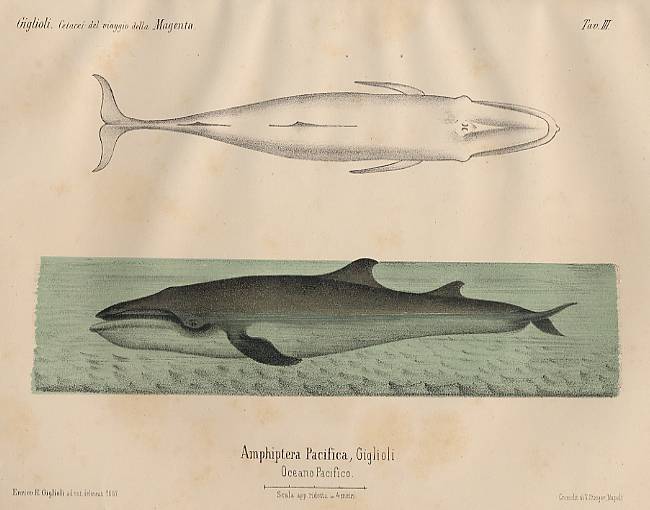- Giglioli's Whale
Infobox Paranormalcreatures
Creature_Name = Gigliolis Whale
Image_Caption = As drawn by Giglioli himself
Sub_Grouping = Whale
AKA = "Amphiptera pacifica"
Country =Chile ,Scotland
Region =
Grouping =Cryptid
Habitat = Water
First_Reported = 1867 (legend)
Last_Sighted = 1983
Status = UnconfirmedGiglioli’s Whale ("Amphiptera pacifica") is an unrecognized species of whale observed by
Enrico Hillyer Giglioli . It was described as having two dorsal fins, a feature which no known whales have.Accounts
On September 4, 1867 on board a ship called the "Magenta" about 1200 miles off the coast of
Chile , the zoologist spotted a species of whale which he could not recognize. It was very close to the ship (too close to shoot with a cannon) and was observed for a quarter of an hour, allowing Giglioli to make very detailed observations. The whale looked overall similar to arorqual , 60 feet (18 m) long with an elongated body, but the most notable difference was the presence of two large dorsal fins about 6.5 feet (2 m) apart. No known whales have twin fins, the rorqual only has a single fin and some other whales have none. Other unusual features include the presence of two long sickle shaped flippers and a lack of furrows present under the throats of rorquals.Another report of a two finned whale of roughly the same size was recorded from the ship "Lily" off the coast of Scotland the following year. In 1983 between Corsica and the French mainland, French zoologist
Jacques Maigret sighted a similar looking creature.Existence
Classification
Although it has not been proven to exist, it was given a "classification" by Giglioli. However, scientists would most likely classify the whale under
Balaenopteridae , large baleenwhales .Possible explanations
The whale may have been a
genetic mutation . Anothercryptid with two dorsal fins is the fabledRhinoceros Dolphin .Whaling
Given the species' alleged size (60 feet) and attributes (it resembles a rorqual), it is extremely doubtful such a species would not have been taken (and reported) by modern commercial whalers, bringing into doubt its very existence.
References
* [http://www.cryptozoology.com/glossary/glossary_topic.php?id=224 Cryptozoology.com entry]
Wikimedia Foundation. 2010.
